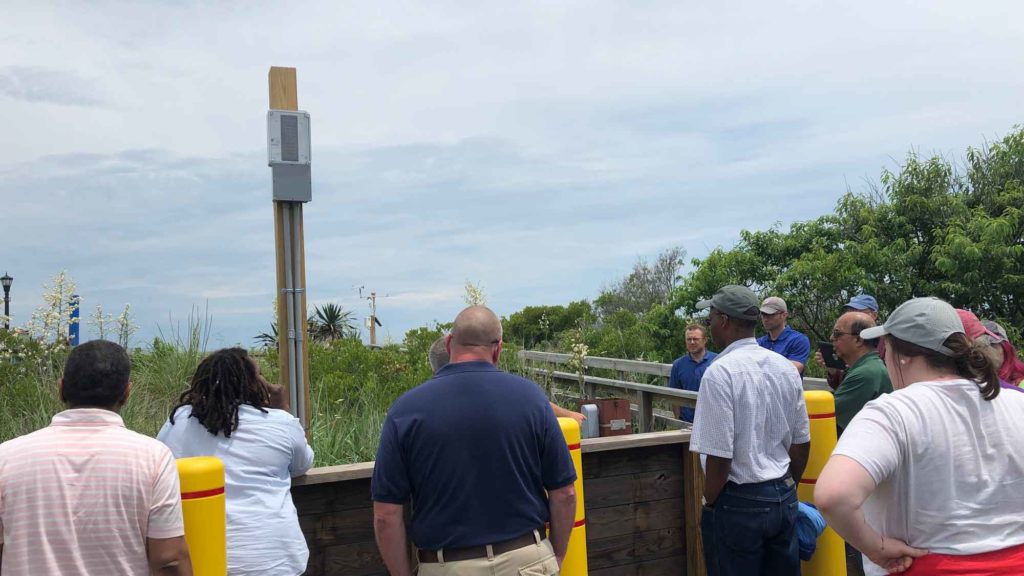Overview
A coastal town reliant on aquifers for its drinking water works to prevent saltwater intrusion by diversifying water sources and installing monitoring equipment to provide near-real-time, actionable data.
Challenge
During his many years in Bethany Beach, Delaware, Water Department Director Ron Foreman has seen a huge increase in the coastal community’s summertime population and a corresponding surge in water usage.
Foreman worried that the Manokin aquifer, which had for years been the city’s primary water source, could be susceptible to saltwater intrusion during peak demand. He was also concerned that if a spike in conductivity occurred, insufficient water monitoring practices would fail to identify the problem until it was too late.
Determined to be proactive, Foreman partnered with Delaware Department of Natural Resources and Environmental Control (DNREC) Environmental Program Administrator Steven Smailer to look for alternatives.
Solution
The decision was made to drill additional production wells in the Pokomoke aquifer situated above the Manokin. The Pokomoke, like the Manokin, is confined, making it less susceptible to contamination. It’s also not as deep as the Manokin, so the water contains less iron and requires less processing to make it potable.
Still, the concern remained that the department simply didn’t have enough information to understand if and when the water supply was at risk.
“We had a few monitoring wells and transducers we’d hook up to periodically along with occasional grab sampling for conductivity, but we certainly weren’t getting enough data,” says Foreman. “If there’d been a problem, we would have been lucky to catch it.”
One option was to do a study of the aquifers, but rather than go through a multidimensional, multiphase modeling exercise to produce results that would still be inconclusive, Smailer recommended that, for a fraction of the cost, the town could install continuous monitoring equipment to see exactly what was happening in near real time.
A coastal management grant helped fund a purchase of In-Situ equipment, including Level TROLL 400s, Aqua TROLL 100s and telemetry. Foreman also brought in In-Situ’s HydroVu Data Services platform, which would deliver monitoring data right to his desk.
Results
Today the Town of Bethany Beach gets its water from three wells in the Pokomoke and maintains one additional well in the Manokin as backup. All are continuously monitored for level and conductivity, and Foreman receives data collected every 15 minutes.
Smailer says that with the new equipment in place, a few things were evident right off the bat. “The first was a spike in conductivity in the Manokin when we turned the wells on – a distinct upcoming that dropped when they were turned off,” he says.
They also saw that, in general, conductivity was rising in the summer and dropping in the winter – something they suspected but hadn’t confirmed with data.
The town currently has two monitoring wells right on the coast and two more that sit closer to the production field. This way Foreman can catch any indication of conductivity moving inland.
“Now we’re getting data constantly,” says Foreman. “I can watch trends and make decisions immediately. The goal,” he adds, “is to prevent damage before it happens. I really feel like we can do that now.”
Foreman says that when they put the new equipment in place, they considered trying to get the data back to their SCADA system. But pulling it into HydroVu was so much simpler.
“It’s just so comfortable to use on its own,” he says. And with such easy access to information, Foreman is able to share it with neighboring towns, many of which are drawing water from the same sources.
For Smailer’s part, he’s intrigued by the fact that Hydrovu features an API that allows users to automatically import data into EarthSoft’s EQuIS Collect and EDGE platforms.
“With these programs, we have the potential to build a more comprehensive and efficient monitoring system up and down the eastern seaboard,” he says.
Growth, it would seem, is inevitable, but with access to regular, reliable data, Bethany Beach is well-positioned to protect its drinking water supply and help other communities do the same.





